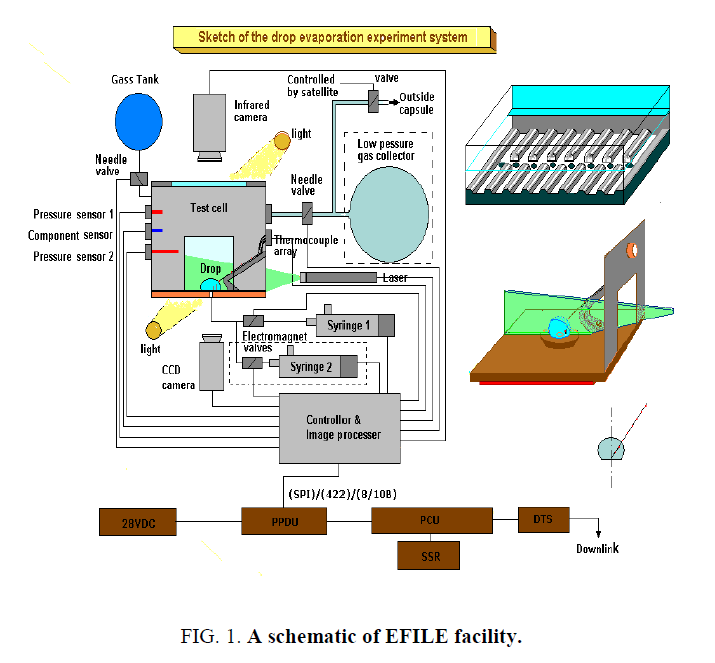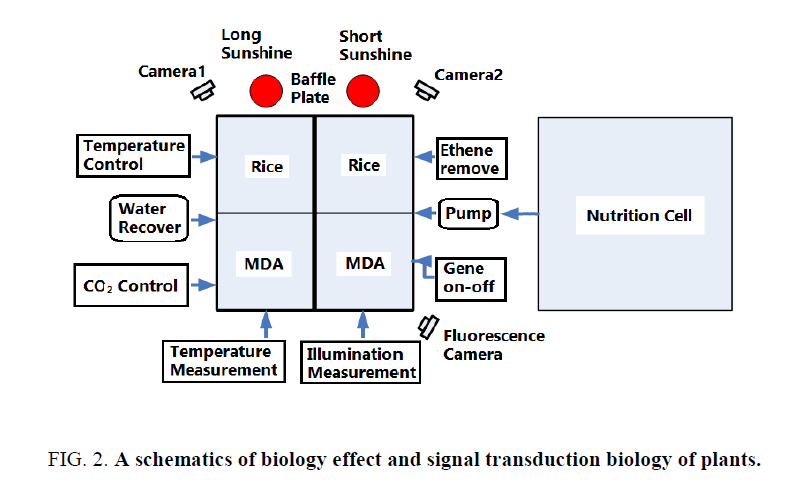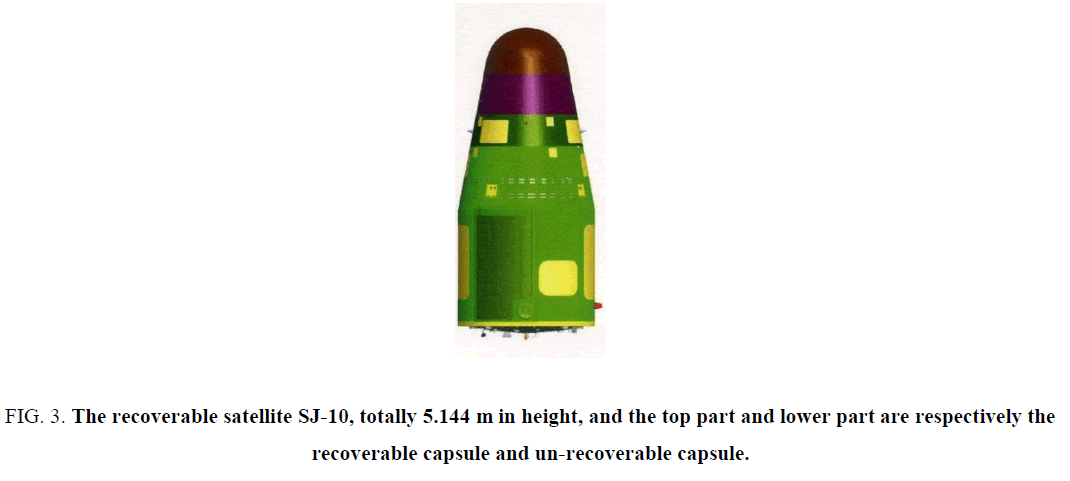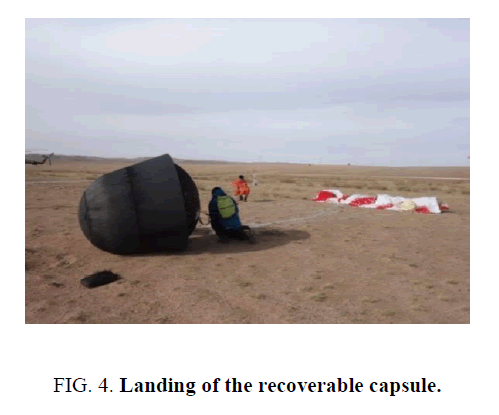Review
, Volume: 5( 1)The SJ-10 Recoverable Microgravity Satellite of China
- *Correspondence:
- Hu WR ,School of Engineering Science, University of Chinese Academy of Sciences, Beijing100190, China,Tel:+86-10-62558226; E-mail: wrhu@imech.ac.cn
Received: July 21, 2016; Accepted: September 04, 2016; Published: September 11, 2016
Citation: Zhao HG, Qiu JW, Tang BC, et al. The SJ-10 Recoverable Microgravity Satellite of China. J Space Explor. 2016;5(1):101.
Abstract
The program SJ-10 is one of the scientific satellite programs in the Strategic Priority Research Program on Space Science, the Chinese Academy of Sciences, and was launched in April 6, 2016. There are totally 19 scientific payloads. Among them, there are two multitask payloads, one is a multi-function furnace for 8 materials research missions, the other is a payload of three-dimensional cell culture for researches on neural stem cell and hematopoietic stem cell. The recoverable satellite consists mainly of two capsules: a recoverable capsule was recovered on April 18, 2016 with all payloads of life science in addition of the payload of the multi-function furnace and the payload for measurements of Soret Coefficients of Crude Oil (SCCO), and an un-recoverable capsule persisted to work in additional 8 days of all other physical payloads. The experiments were operated via tele-operations, and all experimental data were received by the ground station in near real time. The data and recoverable samples are analyzed by the teams of experimental program. The development of the recoverable satellite SJ-10, the performance during the space mission, and the recovery procedure were presented in this paper.
Keywords
Scientific satellite; SJ-10; Microgravity science; Space life science; Recoverable satellite
Introduction
The program SJ-10 is one of the scientific satellite programs in the Strategic Priority Research Program on Space Science, the Chinese Academy of Sciences. It is also the first microgravity scientific satellite of China’s 12th five-year programs of space science; moreover, it is the twenty-five recoverable satellite of China. The primary mission of SJ-10 satellite is to promote the development of microgravity science and space life science by means of space experiments dwelling in orbital capsule and recovery capsule of satellite. Total 19 items of space scientific experiments cover microgravity fluid physics, microgravity combustion, space material science, space radiation effect, gravity biological effect, space biological technology, which are conducted on the satellite. In 2006, the China National Space Administration (CNSA) initiated a comprehensive demonstration on space scientific test by means of recoverable satellite. The Chinese recoverable satellite is a useful facility for space microgravity experiments in a relatively longer period, and has been arranged to perform the microgravity experiments since the late of 1980s [1]. The systematic microgravity experiments were completed on board the un-recoverable capsule of the Chinese recoverable satellite SJ-8 which was launched in August of 2006 [2]. Then, the SJ-10 microgravity satellite was prepared, 20 space experiments were selected from more than 200 applications. However, the process has been paused for some reasons, and re-started by changing the management of space science and space scientific satellite from the China National Space Administration (CNSA) to the Chinese Academy of Sciences (CAS) and the National Space Science Center/CAS for detailed administration affairs in the early of 2010s. In 2010, SJ-10 was adopted by the Strategic Priority Research Program on Space Science of Chinese Academy of Sciences, and then engineering project was started. In September 2012, CNSA organized experts to review the scientific goals and payloads configuration. In October 2012, and organized and held a conference to prepare for the start of the SJ-10 recovery scientific satellite project. In December 2012, SJ-10 satellite project started. The SJ-10 satellite is selected as one of the 4 scientific satellites supported by the Strategic Pioneer Research Program on Space Science of the CAS in the “12th Five Years Period” of China (2011-2015). The scientific design [3], scientific payload research [4] and satellite perform have been completed in 2013 and 2015 respectively.
SJ-10 recoverable scientific experimental satellite is specially used in the space experiments of microgravity science and space life science, which was launched by Long March 2D carrier rocket in Jiuquan Satellite Launch Centre at Beijing time 1:38:04, April 6, 2016. The launch achieved a complete success and the satellite was sent to a circle orbit of 255 km in height. At April 18, 11 payloads and biological experiment samples were carried by the recovery capsule of SJ-10 and return to the earth at Siziwangqi Inner Mongolia. Other 8 payloads of follow up and expand experiments of microgravity fluid physics and journal of combustion science were conducted in left rail tank until April 25. By that time, 20 days of space science experiments were all over [5]. China's SJ-10 program was officially started at December 31, 2012, it would use the long time microgravity environment and space radiation conditions provided by SJ-10 recoverable satellite, by technological means of spatial experiments and sample recovery analysis method. The program centered on the basic and frontier issues of microgravity physics and space life science, which cannot be simulated on the earth. These experiments were selected from more than 200 applications. All the biological payloads in addition to the furnace of materials process and the payload for soret coefficient measurement were onboard the recoverable capsule, and other payloads of fluid physics, complex fluids, combustions were onboard the un-recoverable capsule of the SJ-10 satellite. The satellite was launched just 8 hours after the last biological payload was instilled in the satellite to guarantee the limited influence of Earth gravity for the biological samples.
Microgravity Science and Life Science Research
The microgravity science experimental research would seize the leading edge of the development of the international microgravity science-microgravity fluid physics, microgravity combustion science, and space materials science. It is important to understand the important physical processes in space in long time period in addition to the experiments in shorter microgravity on the ground to expand clearly the cognition of the law of physical movement in the extreme environment of microgravity. This research contains: various process about convection, self-organization and phase transformation; heat transfer and mass transfer laws; material ignition, combustion rule, coal combustion mechanism in microgravity; growth and solidification process of new material samples under microgravity. By the improvements and optimization of the surface and space engineering fluid and thermal energy machinery, materials processing and technology, High quality materials which are difficult to grow in the ground gravity field, it can also provide scientific basis and fundamental data for the safety of manned spacecraft, energy and emission reduction.
The life science experimental research would be grasping the leading edge of the development of the international space and the foundation life sciences – space radiation effect, gravity biological effect, space biology technology and basing on the need for space in this particular environment, to recognize this important biological process and understand the basic laws under limited objectives of the above three space life sciences limited objectives:
• The theoretical basis for the establishment of the life activities of plants, animals, microorganisms and other organisms.
• Reveal the molecular mechanism of the important biological processes in microgravity and space radiation environment.
• Applied to the early embryonic development, stem cell growth / differentiation, 3D construction of tissue.
Scientific purposes of these experiments are summarized as follows:
• To promote the basic research experiments of fluid physics, complex fluid dynamics and biology.
• To support the manned space flight for fire safety research.
• To improve the human health by biotechnology studies; and
• To develop the high-technology by experiments of coal combustion, materials processing and biotechnology.
The list of all 28 space experiments on board the SJ-10 microgravity satellite, and two typical facility pictures of microgravity physics and space biology respectively are shown as follows:
Microgravity fluid physics
• Microgravity A1-1 Space experiment of evaporation and Fluid physics fluid interfacial effects (EFILE) (Figure 1), PI: Q.S. Liu (Inst. Mech., CAS).
• Thermal dynamical behavior of vapor bubble during pool boiling (SOBER-SJ10), PI: J.F. Zhao (Inst. Mech., CAS).
Microgravity complex fluid dynamics
• Phase separation and dynamic clustering in granular gas, PI: M.Y. Hou (Inst. Phys., CAS).
• Study on the colloidal assembling, PI: Y.R. Wang (Inst. Mech., CAS).
Microgravity combustion
• Study on ignition, soot emission and smoke Distribution of Wire Insulations by Overload, PI: W.J. Kong (Inst. Eng. Thermophys, CAS).
• Investigation of the coal particles combustion and pollutant formation characteristics under microgravity, PI: H. Zhang (Tsinghua Uni).
• Investigation of the coat powder combustion and pollution formation characteristics under microgravity, PI: M.H. Xu (Huazhong Univ.).
• Ignition and burning of solid materials in microgravity, PI: S.F. Wang (Inst. Mech., CAS).
Space materials science
Solidification and crystal growth in space PI: X.W. Zhang; et al (Inst. Semiconductor, CAS; etc.)
• Space synthesis and characterization of high performance thermoelectric semiconductors;
• Space growth of diluted magnetic semiconductors.
• Growth and properties of InAsSb under microgravity condition.
• Space-growth, numerical simulation and characterization of InGaSb ternary photoelectric crystals;
• Space solidification and defect control of the super alloy single crystals.
• Interfacial phenomena during the melting of the tin-based alloys.
• Synthesis of metal matrix composites by self-propagating reaction under microgravity environment.
• Preparation and wettability properties of Al2O3/ Tibased composites.
Radiation biologics
• Molecular biology mechanism of biology space radiation mutagenesis, PI: Y.Q. Sun (Dalian Maritime Univ.).
• Roles of space radiation on genomic DNA and its genetic effects, PI: H.Y. Hang (Inst. Biophysics, CAS).
• Effects of space environment on silkworm embryo development and mechanism of mutation, PI: Y.P. Huang (Inst. Plant Physiology & Ecology, CAS).
Gravitational biologics
• Biological effects and the signal transduction biology of microgravity stimulation in plants (Figure 2), PI: W.M. Cai (Inst. Plant Physiology & Ecology, CAS).
• Biomechanics of mass transport of cell interactions under microgravity, PI: M. Long (Inst. Mech., CAS);
• Photoperiod-controlling flowering of Arabidopsis and rice in microgravity, PI: H.Q. Zheng (Inst. Plan Physiology& Ecology, CAS).
Biotechnology
• Three-dimensional cell culture of neural stem cells in space, PI: J.W. Dai (Inst. Genetics & Developmental Biology, CAS).
• Three-dimensional cell culture of hematopoietic stem cells in space, PI: Y. Zhao (Inst. Zoology, CAS).
• Development of mouse early embryos in space, PI: E.Q. Duan (Inst. Zoology, CAS).
• Potential and molecular mechanism of osteogenic differentiation from human bone mesenchymal stem cells, PI: J.F. Wang (Zhejiang Univ.).
All experiments were completed by the space procedure, and the experimental operation were adjusted by the technique of tele-operation. The results of experimental data and pictures were obtained by the PIs in nearly the real time (a few hours’ delay) of the experimental operation. The recoverable samples were sent to the scientists only several hours later then the recoverable capsule were recovered on the ground. Eight experiments of space materials sciences were completed by a multi-function furnace one by one. The temperatures of melting point are 800°C for some samples. However, the real highest temperature in the furnace was only a bit more than 600°C due to slight heat leakage of the furnace. Therefore, only half of the eight experiments were completed successfully. Generally, the experiments on board SJ-10 satellite are successful, and the preliminary scientific results will be completed after a research work in the laboratories on the ground in the near future.
Recoverable Satellite of SJ-10
The recoverable satellite is a very useful spacecraft for microgravity experiments [6], and the satellite of SJ-10 is the 25th recoverable satellite of China. The structure of SJ-10 satellite is shown in Figure. 3.
Figure 3: The recoverable satellite SJ-10, totally 5.144 m in height, and the top part and lower part are respectively the recoverable capsule and un-recoverable capsule.
The SJ-10 satellite flies in a circular orbit of 255 km, and its main parameters are given in Table 1.
| Total mass | 3600 kg |
| Orbital Inclination | 43° |
| Orbital altitude | ~255 km |
| Life span | 12+8 days |
| Quasi-stable microgravity level | Better than 10-3 g (@ ≤0.1Hz) |
| Payload | 270 kg (recoverable capsule) |
| 280 kg (un-recoverable capsule) | |
| Rocket | CZ-2D |
| Launch date | April 06, 2016 |
Table 1: Parameters of SJ-10 satellite.
The method of tele-science was used during the experimental period. The space experiments were operated by the flight control system as follows, and the PIs can adjust the experimental parameters during the experimental period. The satellite program development is scheduled to be 36 months, and the phases are arranged as follows:
Scheme design phase (January 01, 2013 to September 29, 2013)
• Through detailed analysis of various payload demands, full consideration of all the needs of the payloads and related constraints of satellite, to establish effective load service and support system.
• Determining the load and payload service, support systems and satellite mechanical and electrical interface, and load and payload service, support systems electrical interface.
• Verification test on the key technology involved, to develop a scheme to meet the load demand.
Prototype phase (September 30, 2013 to October 31, 2014)
• An effective load and load service and support system prototype sample product development, to complete product identification level environmental test.
• Payload subsystem debugging, in the desktop united debugging of the satellite system electrical parts.
Flight model phase (November 01, 2014 to April 06, 2016)
• An effective load and load service and support system prototype sample product development, complete acceptance level environmental test.
• Load debugging by systems, after flight model's delivery of overall, varies debugging of the flight model, various tests before leaving the factory and in the launch site included.
Flight test phase (April 06, 2014 to April 21, 2016)
• Flight in the designed orbit.
• Perform the space science experiment in order, and transfer the scientific data to the ground station.
• Analyze the scientific data in real time of space experiments.
• Analyze the scientific results from the recoverable facilities.
SJ-10 satellite based on the previous recovery satellites had 11 functional systems including payloads, power system, AOCS, TT&C, data handling, propulsion, structure system, thermal system, recovery system, engineering measurement and antenna system. The payloads divided into two parts, one part called payloads support subsystem connected the platform and scientific equipment, and the other part called experiment subsystem actuated the experimental operations. According to the experimental requirements, we redesigned many systems and innovated many products, and then the satellite had large improvement compared with previous FSW satellite [6]. However, there are many improvements in the SJ-10 satellite technology, briefly as follows:
• Selecting Siziwangqi as landing site for recovery satellite initially. The recoverable capsule of SJ-10 reentry with ballistic type. Precise landing distribution was achieved by means of correct errors control about 15 initial reentry parameters, also accomplished quick search and recovery.
• Initial adoption of active thermal control technology in recovery capsule. To fulfill the compacting installation of payloads in recovery capsule and the high accuracy temperature control of high power cost payloads, we adopted an active thermal control method which combined heat-collecting cold panel and heat radiator.
• Initial adoption low thrust actuator on recovery satellite. The propulsion system configured 1 N thruster and optimized the layout of thrusters, which is to improve the micro-vibration environment.
• The design of platform microgravity environment and the development of microgravity data collecting system. We guaranteed the microgravity level through optimizing lay-out and separation of moving parts and selecting higher orbit altitude. Meanwhile we developed multi-degree of freedom subdivision microgravity measurement devices, which provided flexible operation for microgravity data collecting.
To carry out the 4 aspects mentioned, satellite system developed many kinds of technique products, such as large scale heat-collecting panel, heat radiator and pop-throw auxiliary device, high accuracy micro-vibration data collecting system, pipe connecting two capsules tighten and release device and antenna shield. To suit for the demands of experiments, satellite system adopted multi-model data handling system and instruction control system, then provided flexibility for experiment operations and the ability to support remote operation. As the payloads having many different needs in test, sample installation and recovery support, satellite system optimized the interfaces and procedure to fulfill multi-batch payloads installation. The latest payloads installation was 5 hours before launching. To support 19 scientific research projects which belongs to 6 science domains in microgravity science and space life science, satellite system based on the mature recovery satellite platform and we innovated in system design, lay-out and installation, high accuracy thermal control, microgravity level guarantee, remote operation, autonomous operation and control, engineering and scientific data handling. Through professional development and elaborate operation, satellite system accomplished the mission successfully and performed very well.
Performance During Space Mission
Thermal control
The temperature in pressurized capsule was 20°C at the beginning of space flight, declined with the β decreasing and different payloads power cost and stabled at 10°C at the end of mission. The temperature was 8°C~22°C during the whole mission satisfying the design requirement. During the orbiting phase, the fluid circulation system in recovery capsule worked well. The temperature at blending point was controlled at 20°C during orbiting phase and was modified to 10°C when 14 h before returning. The temperature of payloads in recovery capsule was stable at 21°C~23°C, and declined to 10°C~13°C as planned, satisfying 5°C~35°C the design requirement. After landing, the temperature of payloads in recovery capsule was about 15°C~17°C and 5°C go up compared to that at the end of orbiting phase. The temperature stabled at the optimum state between power cost and sample frozen, fulfilling the mission requirements.
Microgravity level
The total quasi-stable state acceleration was about 1.2 × 10-6 g caused by atmosphere friction and tidal force. The quasi-stable state acceleration was about 10-6 g to 10-5 g when the attitude thrusters worked, and not more than 3 × 10-5 g caused by attitude angle rate. SJ-10 satellite installed 2 multi-channel flexible silicon microgravity sensors to achieve micro-vibration data whose frequency lowers 300 Hz accurately. The micro-vibration (0.1 Hz to 300 Hz) level was better than 1.5 × 10-3 g during the whole mission. The micro-vibration test result in extensive phase showed the micro-vibration peak value was about 7 × 10-4 g, 2 × 10-6 g and 8 × 10-5 g caused by fans in pressurized capsule, thermal control valve and gyros action separately. Above all, the platform quasi-stable state microgravity level is lower than 10-5 g, which is better than the requirement from satellite and its applications (better than 10-3 g).
Satellite time system
The time system performed well during the whole mission. The satellite ground time error accuracy was ± 1 s during the orbiting phase and ± 2 s during the extensive phase.
Power
SJ-10 adopted the high-mass-energy-ratio chemical battery to supply the power demand of platform and payloads. 8 batteries paralleled to provide abundant energy for payloads. The payloads cost 39 Ah during launching phase, 5058 Ah during orbiting phase, 1750 Ah during extensive phase. The 19 items of payloads consumed 6808 Ah totally during the whole mission. From the injection into the orbit to recoverable capsule return, the voltage of battery pile stabled at 27.69 V, fulfilling the design requirement. The voltage of battery pile decreased to 22.65 V at the end of extensive phase and each battery discharged 870 Ah.
The Recovery Procedure
Recovery capsule landed at 16:30 on April 18 (Figure. 4). The research group arrived the place where the recoverable capsule landed at 16:45, then checked and disposed recovery capsule. The recovery capsule landed at a good state without deformation. The capsule was intact, the ablation structure was normal, and the capsule surface showed compact and black without flake. After disposed at landing place, the capsule was transported to the field where recovery group brought out payloads and scientific samples by helicopter. Recovery group completed the removal of 19 scientific devices and handed over them to scientists and customers.
Conclusion
The recoverable satellite is a very useful tool for space microgravity experiments. The Chinese recoverable satellite is a useful infrastructure for microgravity physics and space life science, and the microgravity experimental satellite SJ-10 was launched on April 6, 2016 and recovered on April 18, 2016 successfully. The first Chinese recoverable satellite was launched in 1975, and 23 recoverable satellites have been launched and recovered successfully since then. The 24th recoverable satellite is designed especially for space microgravity experiments of microgravity physics and space biology, which is determined as the program SJ-10, all the experimental facilities, was operated very well.
The SJ-10 program was started on 2008 by CNSA for the phases of selection space experiments, engineering preparations of space techniques and scientific facilities designs. Unfortunately, the program was paused before the starting of the engineering phase. The SJ-10 program is re-started and re-organized by the Strategic Priority Research Program on Space Science, CAS since 2011, and now is completed step by step of all engineering phase. The ground scientific theoretical and experimental researches for analyzing the space experimental data and pictures are in the progress. It is expected that the space experimental results will be studied to give many fruitful scientific results on microgravity science and space life science in the near future.
Acknowledgments
The present study is supported financially by the Strategic Priority Research Program on Space Science, the Chinese Academy of Sciences under the grant of XDA04020000 and the National Natural Science Foundation.
References
- Lin LY, Ke J, Ma JR, et al. Microgravity Science and Space experiment. Peking: Sci-TechPress of China; 1988.
- Hu WR. Microgravity Experiments on board the Chinese Recoverable Satellite. Microgravity Sci Tech. 2003;20(2):59-143.
- Zhao JF, Kang Q. Ground-based researches related to microgravity science experiments aboard SJ-10. Microgravity Sci Tech. 2016;28(2):79-188.
- Hu WR, Zhao JF, Long M, et al. Space program SJ-10 of microgravity research. Microgravity Sci Tech. 2014;26:159-69.
- Kang Q, Hu WR. Microgravity Experimental satellite SJ-10. BullChinese AcadSci. 2016;31(5):574-80.
- Li CH, Zhao HG, Ni RL. China?s Recoverable Satellite and Their Onboard Experiments. Microgravity Sci Technol. 2008;20(2):61-6.





